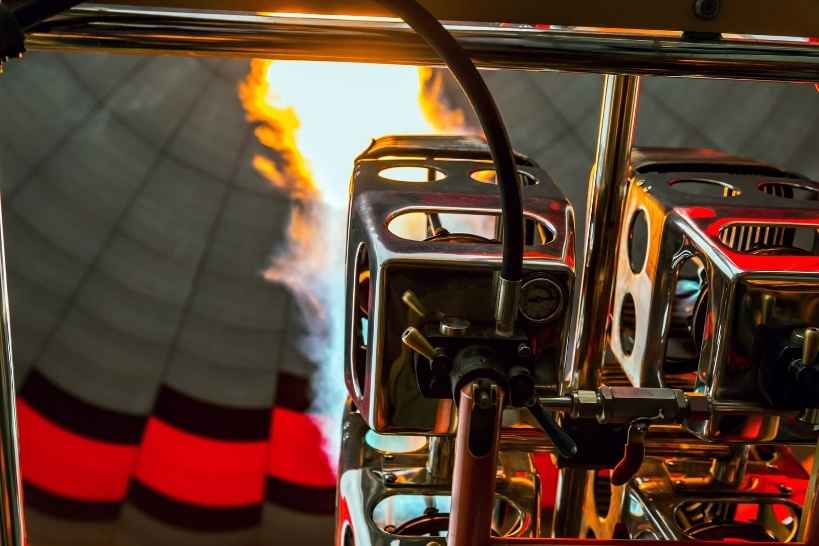Hot Air Ballooning has been around for a long time, however in the modern world climate consciousness is increasing. Worries over global warming, and the human effect on it, can be a cause for concern among prospective passengers.

Do Hot Air Balloons Pollute? Yes, although it should be noted that the pollution of hot air balloons is significantly lower than other forms of aviation. Not just in terms of carbon dioxide and greenhouse gases, but in other potential hazards posed to our environment.
In a larger balloon on a shorter hot air balloon ride, 10 gallons of liquid propane would produce 126.8lbs of coal, or 58kg of CO2 being put into the atmosphere, by only one entire balloon. So how does one 105,000 cubic foot balloon compare to other fuels, aviation hobbies, and polluters? Let’s take a look.
Propane
Hot air balloon flights do not burn a traditional fossil fuel, instead using a mix of liquid propane and oxygen to get the balloon aloft. Propane is essential to reducing the balloon flight carbon footprint, as well as protect the passengers and crew in the basket.
So compared to a traditional fossil fuel like petroleum or gasoline, or even diesel and kerosene, how does propane compare? Burning gallons of gasoline would produce 19.37lbs of CO2 per gallon, and that’s surprisingly one of the less polluting fuels. Kerosene is one of the worst polluters, creating 21.78lbs per gallon, and diesel makes even more at an astounding 22.46lbs a gallon.
Another thing to note is the pollution created during the manufacturing and processing of these alternative fuels. Turning oil into gasoline is an extensive and costly procedure for the environment, and an air balloon ride company will likely never compare in pollution to an oil giant.
Propane burners are far superior for the safety of both the environment and passengers than, say, coal burners. So don’t let environmental concerns dissuade you from an unforgettable balloon ride.
Burning Propane
How much liquid propane gets burned during a person’s balloon ride? On a typical flight, you may expect to burn anywhere between 20 and 30 gallons of fuel. This can seem like a lot on its own, but compared to major sources of carbon emission then the hot air balloon volume of carbon dioxide is negligible.
According to the United States Environmental Protection Agency (EPA) a single passenger vehicle produced 4.6 metric tons of CO2 a year. Motor vehicles are driven everyday, while a person balloon ride requires an exact meeting time.
Ballooning is also quite a seasonal event, meaning they’re rarely in constant use. Instead burners will release into the envelope from time to time, maintaining the altitude of the balloon. As a result, hot air balloon flights make a very minor impact of the environment, so small compared to major polluters that you wouldn’t even notice it on a chart.
Propane also burns more cleanly than other comparable sources. This is because propane is able to near completely combust in the open air. Complete combustion is superior to incomplete combustion, which is often indicated by heavy smoke and wasted fuel.
Propane can form carbon monoxide, a deadly gas that should not be inhaled. However, this only forms if there is insufficient air to combust and form CO2. In a hot air balloon, there will never be a shortage of air surrounding the burner for ignition.
Modern Designs
Just because passenger balloon rides aren’t a major polluter doesn’t mean that steps aren’t being taken to find and design a better way forward for ballooning. The most common of these measures would be a hot air balloon motor, attached to basket. A single balloon with a motor is capable of better handling and steering.
A hot air balloon motor can reduce gas consumption, as an amateur or even exceptional balloon flight team will find it easier to choose a direction. Otherwise, extra propane must be burned in order to ascend and descend to particular heights, where wind speeds can help dictate a flight path.

Future Designs
Other hot air balloon equipment is also available, and still in development. Other than a hot air balloon motor, you can see new Ultramagic Balloons which aim to cut down on fuel consumption even further. Hot air balloon flights are still being improved upon, all with an eco-friendly design policy.
Spain-based Ultramagic Balloons, with their design of a new balloon envelope to better insulate the heated air, hope to cut fuel consumption by a third. This would see a significant decrease in greenhouse gases produced by sport ballooning, hot air balloon flights, and balloon rallies.
This would come with an additional $100,000 price tag, but the recycling of balloon materials is not totally uncommon. Just another way hot air ballooning is striving to be eco-conscious, with second-hand and used materials still being put to good use.
The same company have also been looking at ways of making hot air ballooning safer. They have developed an app to help track sporting balloons in real time, helping competition organisers keep pilots safe and on course. In the awful event of a balloon going stray, the app will point a chase crew and a rescue the right direction.
Other Environmental Hazards
Pollution from greenhouse gases aren’t the only concerns for the environment however. Noise pollution, balloon debris, and electrical burners must be considered as well. Thankfully, noise pollution is minimal from a hot air balloon ride, since they are totally silent save from the burning of fuel, something which is not constant.
Debris is also unlikely to be an issue, except in the case of extreme hot air balloon accidents. Most hot air balloon accidents occur when the balloon lands, resulting in more minor injuries such as whiplash. Yet, even these are uncommon during an average balloon landing.
Unless you are riding in a one or two passenger sport balloon, you are unlikely to be equipped with a hot air balloon motor just yet. As such, you will not have to worry about electrical failures, and even if you did the worst case would be further use of propane to steer.
From time to time, burner malfunctions can occur. The burner can get quite hot, and make standing in a hot air balloon basket quite uncomfortable. However, once the fuel is out then the balloon will begin to descend, with most balloons having an operational altitude of 3000 feet.

Other Polluters
As you might expect from a fuel such as oil, there are other threats posed by the fuel. Images of large oil spills and thick crude oil causing damage are some of the most powerful calls to action in the fight against climate change. However, liquid propane has very few of these issues.
Liquid propane doesn’t dissolve in water, so if some were to be lost during your hot air ballooning adventure then it is unlikely to poison or harm any animal or person as a result of drinking it. Not only that, but propane is non-toxic.
An accident involving a loss or spilling of liquid propane would also not damage soil fertility, as it is non-harmful. This means aside from an initial accident, propane is unlikely to be damaging to the environment in any significant capacity.
I’m Annie, a twenty-something year old girl who loves hot air balloons. So much so, that I have a full time job as a Flight Instructor and it is all I love talking about. Something about being up there in the elevated altitudes helps all my stresses float away!